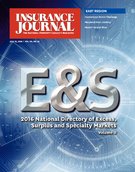Industry Says Affordability Definition Will Lead to Confusion on Price
If the average auto insurance liability premium paid by consumers in minority and low-income neighborhoods is more than 2 percent of the median income in those neighborhoods, the auto insurance will be considered unaffordable, under a new index being adopted by the federal government.
The Federal Insurance Office (FIO) within the Treasury Department said it has determined the methodology and guidelines for the auto insurance affordability index after discussion with industry, regulatory, academic and consumer interests.
“Access to affordable auto insurance is crucial for consumers who commute to work, drive kids to school, and meet the needs of their families,” said Michael McRaith, FIO director. “This new methodology reflects important feedback FIO has received from a number of key stakeholders, and it is a meaningful step toward better understanding the affordability of auto insurance for consumers and underserved communities all across the country.”
The FIO has been developing the rule for several years as part of its authority under the Dodd-Frank Wall Street Reform and Consumer Protection Act to monitor the extent to which underserved communities and consumers, minorities, and low- and moderate-income persons have access to affordable insurance products.
Some insurers and other financial firms opposed the use of any numerical index, arguing such an approach is too simplistic to measure affordability. Consumer and civil rights groups have generally supported the methodology and the fixed percentage, although FIO did not incorporate all of the conditions they sought.
After the Index
FIO said it will study and report on the affordability of automobile insurance using the methodology annually. It is not clear what FIO will do with its findings beyond reporting them. Auto insurance is regulated by states, not the federal government.
Insurers expressed concern over how the public and policymakers may interpret FIO’s reporting of the index in the future.
“By law, the FIO monitors the markets and will report to Congress, which can act on those reports or not,” said Jimi Grande, senior vice president of federal and political affairs for the National Association of Mutual Insurance Companies (NAMIC).
“What’s troubling is that even though the FIO itself recognizes that ‘affordability for any individual consumer can be assessed accurately only within the context of that consumer’s circumstances,’ the conclusions others draw from the office’s reports based on aggregated data will not take this fundamental fact into account, or ignore it outright to further an agenda.”
Two Percent Solution Debate
The FIO’s index is calculated by dividing the average annual personal automobile liability premium by the median household income for ZIP codes identified as being majority-minority or majority low-and-moderate income. If the resulting number is less than 2 percent, insurance is considered affordable, according to FIO. If it is above 2 percent, the auto insurance is presumed unaffordable.
The major debate in the methodology concerned whether an index of a single percentage can define affordability.
Insurers and other financial firms argued that 2 percent misrepresents the term “affordable” and is unjustifiably low. They expressed concern that it could create a perception that auto insurance is inexpensive and the price can be adjusted for particular consumers.
The National Association of Professional Insurance Agents (PIA) warned that defining affordability in terms of a percentage could lead to a call to “fix” the problem through some kind of a subsidy.
The Insurance Research Council (IRC) told FIO that the 2 percent figure is arbitrary and that there is no external standard to support it. An affordability index relating the cost of auto insurance coverage to income is an appropriate method for monitoring affordability over time, however, it is not an appropriate method for presuming auto insurance to be affordable or unaffordable, according to IRC.
FIO said it recognizes the shortcoming of an index that reduces complex factors into a single formula, but other federal agencies and private sector groups use indices to measure affordability, including the Consumer Price Index (CPI) by the Bureau of Labor Statistics and Housing Affordability Index by the National Association of Realtors.
FIO said it considered that the overall cost of living varies considerably across the nation and that variation is reflected in part by the variation in household income. By basing the threshold on a specific percentage of household income, the measure will adjust for the variations in the overall cost of living and income levels by region. Using household income at the ZIP code level is superior to other approaches because it is used to analyze affordability of other consumer products, FIO said.
Data Questions
During the rulemaking process, FIO and participating groups raised questions about what premium data to use – quoted or written? liability only or all coverages? nonstandard market as well as standard? – and what household income data to use – average or median? national or local?
FIO chose average written liability premiums from the standard market only and median income tied to ZIP codes based on available data.
Some consumer advocates objected to the use of written premium over quoted premium, arguing that it overlooks the likelihood that some consumers may not purchase insurance if they receive quotes that are too expensive.
Some insurers argued that using liability premiums would invite data quality issues because state minimums vary, but other insurers supported FIO’s view that an affordability index should measure only the cost of mandatory liability coverage. FIO said it decided to use liability premiums because liability coverage (or financial responsibility limit) is the only requirement imposed by states as a condition of driving or owning an automobile.
FIO said it only uses premiums in the standard market to diminish the impact of the higher annual premiums charged to the highest risk drivers in the other markets. Some consumer advocates wanted FIO to include data from the nonstandard and residual market as well.
Data Collection
The agency said it will first use existing aggregated premium data from the industry along with U.S. Census Bureau data in its methodology. Consumer groups had called for FIO to do a separate data collection, while insurers wanted FIO to use data already available. But this year FIO said it will only use data available from the Census Bureau and from insurers via 133 statistical agents and the 20 states that require insurers to report ZIP code automobile premium data to one of three statistical agents (ISO, ISS and NISS).
For its study in 2017, FIO said it will request data from insurers that have a statutory surplus greater than $500 million as of Dec. 31, 2015, and that annually collect more than $500 million of premium for personal auto insurance. For 2017, FIO will request that large insurers that do not already report ZIP code level premium data voluntarily provide that data to the statistical agents with which they typically work.
Consumer Interests
More than 50 consumer and civil rights groups including the Consumer Federation of America, U.S. PIRG, NAACP, and National Council of Raza have backed FIO’s efforts and the 2 percent threshold. Leaders of the 50 groups said: “FIO has begun to tackle an important responsibility established for it by the Wall Street Reform and Consumer Protection Act. Auto insurance is a unique product, the purchase of which is required of every driver in all but one state. Yet it is sold under different rules in every state, and within states, even within localities, drivers with perfect records can be charged dramatically different premiums. Until now, there has been no federal entity tasked with understanding how the cost of this mandated product impacts low- and moderate-income Americans, people of color or underserved communities.”
Insurers’ Reactions
Property/casualty insurance groups generally expressed doubts about the fairness and accuracy of FIO’s methodology because the income level it uses fails to consider other household expenditures, driver risk factors, other cost drivers of insurance and differences among state-based insurance systems.
“The mission of monitoring affordability of auto insurance as required by law is an ill-defined and nearly impossible task that asks the FIO to create a standardized metric of something that is inherently subjective,” said NAMIC’s Grande. “The methodology ignores all existing government data on auto insurance expenditures and even the fundamental principle that insurance should be priced according to risk, which means the same standard would be considered for a driver with a perfect driving record and one with multiple accidents. There is great danger in arbitrarily establishing a threshold for which our government will deem a product affordable. What’s next – whether the car itself is considered affordable?”
Lisa Brown, senior counsel and director, Compliance Resources, for the American Insurance Association, said there is a need for clear regulatory guidelines and definitions of “affordable.” “Factors such as state-based tort reform laws, consumer choice in levels of coverage, and state minimum insurance requirement laws do not appear to have been taken into account while FIO devised this methodology,” she said.
Topics Carriers Auto Profit Loss Agencies
Was this article valuable?
Here are more articles you may enjoy.



 Microsoft Tells Texas Agencies They Were Exposed in Russian Hack
Microsoft Tells Texas Agencies They Were Exposed in Russian Hack  US P/C Underwriting Results: Two Years in a Row Over $20 Billion in the Red
US P/C Underwriting Results: Two Years in a Row Over $20 Billion in the Red  Supreme Court Overturns Chevron Rule in Blow to Regulators
Supreme Court Overturns Chevron Rule in Blow to Regulators  ‘Extremely Dangerous’ Hurricane Beryl Takes Aim at Caribbean
‘Extremely Dangerous’ Hurricane Beryl Takes Aim at Caribbean 


